
Researchers in the Netherlands looked at 2,000 people who had suffered a thrombosis for the first time. They found that 233 had travelled for more than four hours in the eight weeks beforehand.
Travelling in general doubled the chances of having a venous thrombosis, or blood clot in a vein – although the risk was low to start with.
The hazard was greatest in the first week after travelling, and the overall risk of flying was no worse than going by car, bus or train.
Particular groups of people – especially women on the Pill – were more at risk than others, the researchers found.
Long-distance travel was associated with an eight-fold increased risk for those with a specific mutation in one of the genes involved with clotting, called factor V Leiden.
The mutation is especially common among individuals of Scandinavian descent. The risk was increased almost ten-fold for people who were obese, and four-fold for individuals who were more than 6ft 2¾in tall. Women taking oral contraceptives were by far the most at risk. For them, travel boosted the chances of having a thrombosis more than 20-fold.
For these different groups assessed individually, the risk findings were most apparent for air passengers.
In addition, being shorter than 5ft 3in was associated with a five-fold increased risk of thrombosis after air travel
